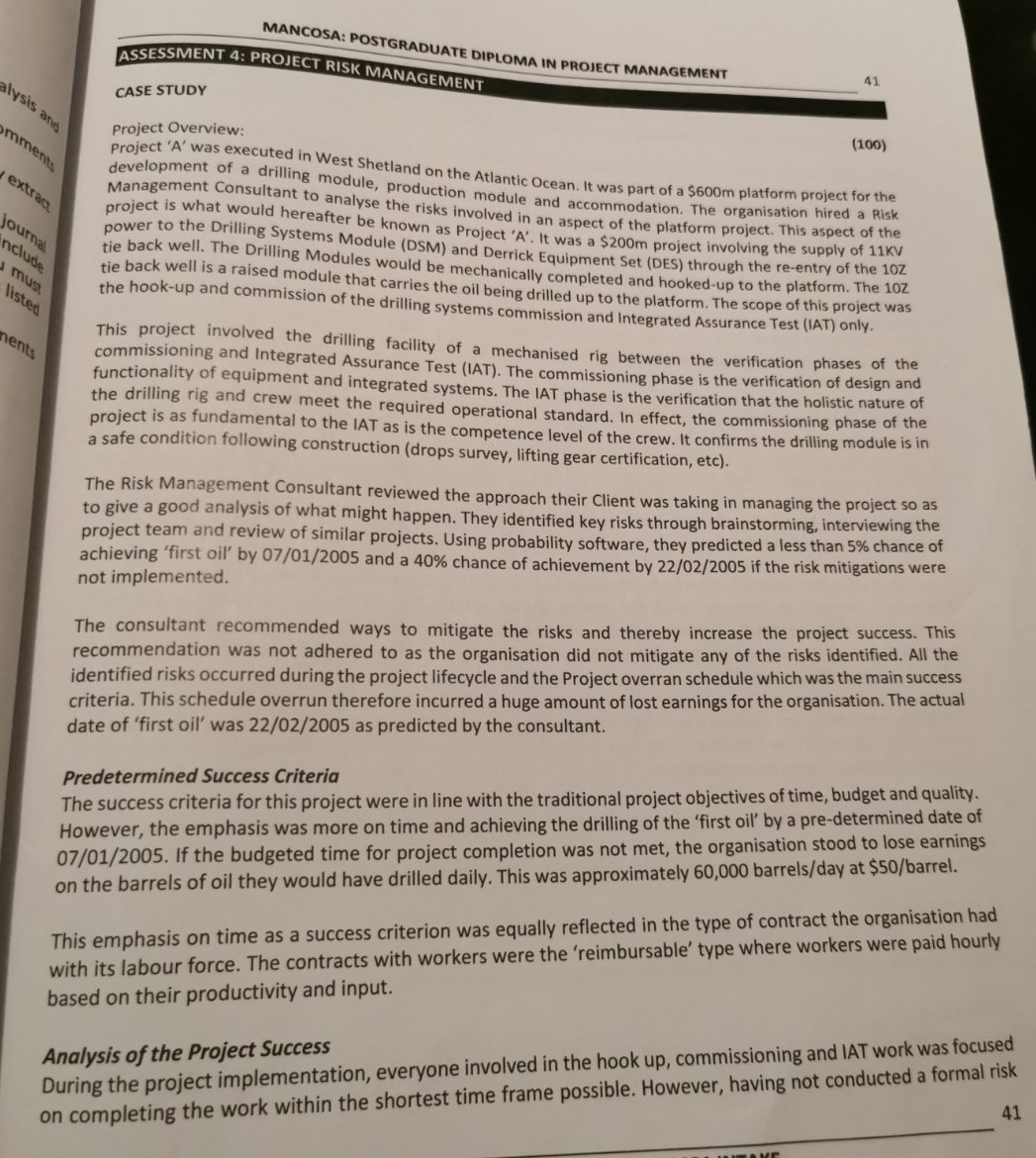Kindly read the attached Case study and answer the following questions : Questions 1; Risk identification and mitigation throughout the lifecycle of the project was necessary. Critically discuss theory associated with lifecycle phase risk identification and how it relates to the project. Question 2; The case study shows that the risk consultant utilised risk identification techniques. Elaborate on the different risk identification techniques and indicate how they were relevant to the project in the case study? Question 3 : As we can from the case study, ignoring risks can be detrimental to the delivery of a project. Discuss the benefits of the project risks management and show how these benefits are relevant to the project in the case study above? Questions 4 : Prudent Risk management requires that all stakeholders support the management of risks. By referring to risk management principles, discuss in detail how the risks of the project in the case study were managed.
MANCOSA: POSTGRADUATE DIPLOMA IN PROJECT MANAGEMENT ASSESSMENT 4: PROJECT RISK MANAGEMENT CASE STUDY lysis and Project Overview: (100) mments project 'A' was executed in West Shetland on the Atlantic Ocean. It was part of a $600m platform project for the development of a drilling module, production module and accommodation. The organisation hired a Risk extract Management Consultant to analyse the risks involved in an aspect of the platform project. This aspect of the project is what would hereafter be known as Project 'A'. It was a $200m project involving the supply of 11KV journal power to the Drilling Systems Module (DSM) and Derrick Equipment Set (DES) through the re-entry of the 107 nclude tie back well. The Drilling Modules would be mechanically completed and hooked-up to the platform. The 10z must tie back well is a raised module that carries the oil being drilled up to the platform. The scope of this project was listed the hook-up and commission of the drilling systems commission and Integrated Assurance Test (IAT) only. ments This project involved the drilling facility of a mechanised rig between the verification phases of the commissioning and Integrated Assurance Test (IAT). The commissioning phase is the verification of design and functionality of equipment and integrated systems. The IAT phase is the verification that the holistic nature of the drilling rig and crew meet the required operational standard. In effect, the commissioning phase of the project is as fundamental to the IAT as is the competence level of the crew. It confirms the drilling module is in a safe condition following construction (drops survey, lifting gear certification, etc). The Risk Management Consultant reviewed the approach their Client was taking in managing the project so as to give a good analysis of what might happen. They identified key risks through brainstorming, interviewing the project team and review of similar projects. Using probability software, they predicted a less than 5% chance of achieving 'first oil' by 07/01/2005 and a 40% chance of achievement by 22/02/2005 if the risk mitigations were not implemented. The consultant recommended ways to mitigate the risks and thereby increase the project success. This recommendation was not adhered to as the organisation did not mitigate any of the risks identified. All the identified risks occurred during the project lifecycle and the Project overran schedule which was the main success criteria. This schedule overrun therefore incurred a huge amount of lost earnings for the organisation. The actual date of 'first oil' was 22/02/2005 as predicted by the consultant. Predetermined Success Criteria The success criteria for this project were in line with the traditional project objectives of time, budget and quality. However, the emphasis was more on time and achieving the drilling of the 'first oil' by a pre-determined date of 07/01/2005. If the budgeted time for project completion was not met, the organisation stood to lose earnings on the barrels of oil they would have drilled daily. This was approximately 60,000 barrels/day at $50/barrel. This emphasis on time as a success criterion was equally reflected in the type of contract the organisation had with its labour force. The contracts with workers were the 'reimbursable' type where workers were paid hourly based on their productivity and input. Analysis of the Project Success During the project implementation, everyone involved in the hook up, commissioning and IAT work was focused on completing the work within the shortest time frame possible. However, having not conducted a formal risk 41







